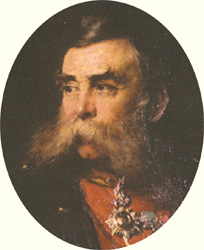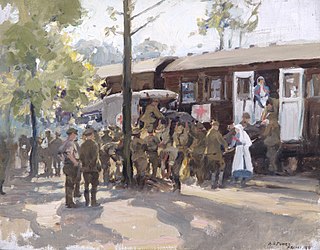Related Research Articles

The Crimean War was a military conflict fought from October 1853 to February 1856 in which the Russian Empire lost to an alliance made up of the Ottoman Empire, France, Britain and Sardinia. The immediate cause of the war involved the rights of Christian minorities in the Holy Land, which was a part of the Ottoman Empire. The French promoted the rights of Roman Catholics, while Russia promoted those of the Eastern Orthodox Church. The longer-term causes involved the decline of the Ottoman Empire and the unwillingness of Britain and France to allow Russia to gain territory and power at the Ottoman Empire's expense. It has widely been noted that the causes, in one case involving an argument over a key, have never revealed a "greater confusion of purpose", yet they led to a war noted for its "notoriously incompetent international butchery".

Sir Samuel Morton Peto, 1st Baronet was an English entrepreneur, civil engineer and railway developer, and, for more than 20 years, a Member of Parliament (MP). A partner in the firm of Grissell and Peto, he managed construction firms that built many major buildings and monuments in London, including The Reform Club, The Lyceum, Nelson's Column and the new Houses of Parliament; which made him a millionaire.

Field Marshal Colin Campbell, 1st Baron Clyde,, was a British Army officer. After serving in the Peninsular War and the War of 1812, he commanded the 98th Regiment of Foot during the First Opium War and then commanded a brigade during the Second Anglo-Sikh War. He went on to command the Highland Brigade at the Battle of Alma and with his "thin red line of Highlanders" he repulsed the Russian attack on Balaclava during the Crimean War. At an early stage of the Indian Mutiny, he became Commander-in-Chief, India and, in that role, he relieved and then evacuated Lucknow and, after attacking and decisively defeating Tatya Tope at the Second Battle of Cawnpore, captured Lucknow again. Whilst still commander-in-chief he dealt with the 'White Mutiny' among East India Company troops, and organised the army sent east in the Second Opium War.

Sir William Howard Russell, was an Irish reporter with The Times, and is considered to have been one of the first modern war correspondents. He spent 22 months covering the Crimean War, including the Siege of Sevastopol and the Charge of the Light Brigade. He later covered events during the Indian Rebellion of 1857, the American Civil War, the Austro-Prussian War, and the Franco-Prussian War.
Chief mechanical engineer and locomotive superintendent are titles applied by British, Australian, and New Zealand railway companies to the person ultimately responsible to the board of the company for the building and maintaining of the locomotives and rolling stock. In Britain, the post of locomotive superintendent was introduced in the late 1830s, and chief mechanical engineer in 1886.

The siege of Sevastopol lasted from October 1854 until September 1855, during the Crimean War. The allies landed at Eupatoria on 14 September 1854, intending to make a triumphal march to Sevastopol, the capital of the Crimea, with 50,000 men. The 56-kilometre (35 mi) traverse took a year of fighting against the Russians. Major battles along the way were Alma, Balaklava, Inkerman, Tchernaya, Redan, and, finally, Malakoff. During the siege, the allied navy undertook six bombardments of the capital, on 17 October 1854; and on 9 April, 6 June, 17 June, 17 August, and 5 September 1855.

Thomas Brassey was an English civil engineering contractor and manufacturer of building materials who was responsible for building much of the world's railways in the 19th century. By 1847, he had built about one-third of the railways in Britain, and by time of his death in 1870 he had built one in every twenty miles of railway in the world. This included three-quarters of the lines in France, major lines in many other European countries and in Canada, Australia, South America and India. He also built the structures associated with those railways, including docks, bridges, viaducts, stations, tunnels and drainage works.

The Grand Crimean Central Railway was a military railway built in 1855 during the Crimean War by Great Britain. Its purpose was to supply ammunition and provisions to Allied soldiers engaged in the siege of Sevastopol who were stationed on a plateau between Balaklava and Sevastopol. It also carried the world's first hospital train.

Edward Ladd Betts was an English civil engineering contractor who was mainly involved in the building of railways.
James Beatty was an Irish railway engineer.

Sir William Montagu Scott McMurdo was a British army officer who rose to the rank of general. He saw active service in India, helped to run a military railway in the Crimean War and then managed various groups of volunteers working with the army. He was eventually knighted.

Field Marshal Sir John Lintorn Arabin Simmons was a British Army officer. Early in his career he served as Inspector of Railways, Secretary of the Railways Commission and then Secretary of the Railway Department under the Board of Trade. He went on to be British Commissioner with the Turkish Army providing advice to General Omar Pasha during the Crimean War. He assisted the Turks at the defence of Silistra and then led them at the Battle of Giurgevo before landing with them at the Battle of Eupatoria and remaining with them for the Siege of Sevastopol. After that he became British Consul in Warsaw, Commander, Royal Engineers at Aldershot and then Director of the Royal Engineer Establishment in Chatham. He went on to be Lieutenant-Governor of the Royal Military Academy and subsequently Governor of the Academy. His last appointments were as Colonel Commandant of the Royal Engineers, as Inspector General of Fortifications and then as Governor of Malta.

A hospital train is a railway train with carriages equipped for the provision of healthcare. Historically this has ranged from trains equipped to transport wounded soldiers, with basic nursing and first aid facilities on board, to fully equipped mobile medical centres, sometimes including operating theatres and nursing wards.

Peto, Brassey and Betts was a civil engineering partnership between Samuel Morton Peto, Thomas Brassey and Edward Betts. They built a supply and casualty transport railway from Balaclava port to the siege lines southeast of Sevastopol in 1855 during the Crimean War. The supply line was instrumental in the success of the siege. The partnership was contracted to produce a number of significant projects around the world including Victoria Bridge in Montreal and the European and North American Railway.
Ian MacDonald Campbell, CVO, FREng, FICE, FCIT was a British civil engineer. He served as chief executive of the British Railways Board (1978–80) and chairman of the Scottish Board of British Railways (1983–88).

The South African Railways Class 6F 4-6-0 of 1900 was a steam locomotive from the pre-Union era in the Cape of Good Hope.

The South African Railways Class Experimental 5 2-8-2 of 1906 was a steam locomotive from the pre-Union era in the Cape of Good Hope.

The Cape Government Railways 3rd Class 4-4-0 of 1898 was a South African steam locomotive from the pre-Union era in the Cape of Good Hope.

Joseph Hobson (1834–1917) was a Canadian land surveyor, civil engineer, and railway design engineer. He was the resident engineer during the construction of the International Railway Bridge and designed the first St. Clair railway tunnel. This was the first underwater railway tunnel between Canada and the USA and, when it opened in 1891, the first undersea tunnel linking two distinct countries and the longest undersea tunnel then constructed.
References
Citations
- ↑ Cooke 1990 , pp. 26–28.
- ↑ Cooke 1990 , p. 41.
- ↑ Cooke 1990 , p. 118.
Sources
- Cooke, Brian (1990), The Grand Crimean Central Railway, Knutsford: Cavalier House, ISBN 0-9515889-0-7
| This article about an engineer, inventor or industrial designer from the United Kingdom or its predecessor states is a stub. You can help Wikipedia by expanding it. |